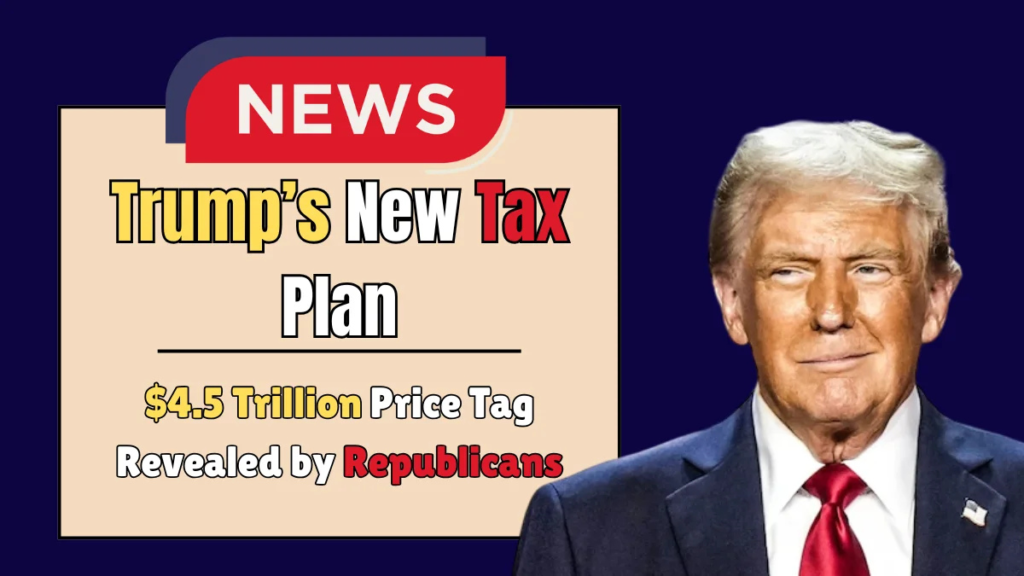Trump’s New Tax Plan May Cost the US $4.5 Trillion: A Summary of Its Economic, Political, and Budgetary Implications Under the direction of House Republicans, a budget resolution to endorse Donald Trump’s economic proposal, which includes $4.5 trillion in tax cuts over 10 years, has been introduced.
The budget resolution calls for an extension and expansion of the 2017 Tax Cuts and Jobs Act (TCJA). The ensuing debate around potential economic impact makes for lively reading. Some proponents claim that tax reductions for individuals and corporations will generate economic expansion, jobs growth, and investment.
Some opponents warn that tax cuts will cause higher national debt, income inequality, and cuts to other important federal programs, such as Social Security, Medicare, and Medicaid. With a divided Congress and $34 trillion in national debt looming, the outcome of this budget resolution will cast the shape of America’s economic and fiscal future. Let’s delve into the details, the implications, and the political environment surrounding this contentious tax plan.
Historical Context What Happened with Trump’s 2017 Tax Cuts?
The 2017 Tax Cuts and Jobs Act (TCJA) was signed into law by Donald Trump, resulting in substantial tax cuts, such as:
Reduction in the corporate tax rate, from 35% to 21%Lower individual income tax rates for most tax brackets The standard deduction increased by 2; it is now double the previous tax law amount for taxpayers. The repeal of the corporate alternative minimum tax (AMT)While beneficiaries of these changes often included corporations and higher-income individuals, the plan added about $1.9 trillion to the federal deficit. Now, Republicans want to continue and expand the tax cuts; they argue that it will create long-term economic growth.
Economic Impact: Who Benefits and Who Could Lose?

Experts are divided on how the new tax plan will affect the economy. Here’s a look at the potential winners and losers:
Potential Advantages of Tax Cuts
- ✅ Firms and Businesses: Lowering corporate rates incentivizes firms to expand operations, hire additional workers, and invest funds to grow the business.
- ✅ High-income Individuals: High-income individuals qualify for the most benefits from decreasing capital gains and estate taxes.
- ✅ Expanded Stock Market Value: Tax cuts stimulate stock prices, thereby stimulating the benefit to stockholders and retirement accounts.
- ✅ Small Businesses: Continuing pass-through deductions would assist small business owners in decreasing taxable income.
⚠️ Risks and Concerns of Tax Act
❌ Higher National Debt: The US currently has $34 trillion in debt, and an additional $4.5 trillion in cuts and no offsetting revenue could worsen the deficit.
❌ Consequences for Americans with Middle- to Lower-Incomes: If cuts are made to programs such as Medicare, Medicaid, or Social Security, families with lower incomes and the elderly may lose basic program benefits.
❌ Continuing Fiscal Stability: With deficits widening, the government may need to borrow more, leading to increased interest rates and inflationary pressures.
What Experts Are Saying About Trump’s Tax Plan
- 📢 “Tax cuts can stimulate short-term growth. Tax cuts can also cause income inequality if not set up fairly and responsibly.” —Joseph Stiglitz, Nobel Laureate
- 📢 “This plan would mean severe spending cuts to important programs such as Social Security and Medicare.” —Center for Budget and Policy Priorities (CBPP)
- 📢 “If the tax cuts do not come with reducible spending cuts, this plan will add to the unsustainable level of debt.” —Committee for a Responsible Federal Budget (CRFB)
Republican Support vs. Internal Party Divisions
While Republicans generally support tax cuts, there are internal divisions on how to fund them.
🔴 Conservative Hardliners
Desire greater reductions in federal programs (e.g., food assistance, housing, and healthcare). Make the case that tax cuts will “pay for themselves” with increased economic growth.
🟠 Moderate Republicans Concerned about political repercussions if cuts to Social Security and Medicare become necessary. Would like a somewhat more measured approach with some revenue-raising proposals. Since Democrats are likely to resist, Republicans may pursue budget reconciliation to get the bill through the Senate without a Democratic filibuster.
What Happens Next? Possible Scenarios
1️⃣ If the Plan Passes
✅ Tax cuts take effect, boosting corporate profits and short-term GDP growth.
✅ Government spending cuts impact social programs.
✅ Deficit concerns lead to higher borrowing costs and inflation risks.
2️⃣ If the Plan Fails
❌ Republicans may propose a scaled-down version to gain moderate support.
❌ The economy continues under current tax laws, which are set to expire in 2026.
Conclusion: A Defining Moment for U.S. Fiscal Policy
Trump’s proposed $4.5 trillion tax cuts to date are among the largest fiscal policy proposal in modern memory. Proponents contend the cuts will spur growth and job creation as well as bring back investment. Critics fear it would balloon the national debt, exacerbate income inequality, and lead to cuts in programs on which people rely. With divisions within the GOP and Democrats very much against, the future of the proposal is uncertain. What do you think? Do tax cuts help or hurt the economy long term?
FAQs
1. What is Trump’s new tax plan?
Trump’s proposed tax plan includes extending the 2017 Tax Cuts and Jobs Act (TCJA), reducing corporate tax rates, and offering additional tax breaks for businesses and individuals.
2. How much is the tax plan expected to cost?
According to Republican estimates, the plan could add $4.5 trillion to the national debt over the next decade if fully implemented.
3. Who benefits the most from this tax plan?
The plan is expected to favor corporations, high-income earners, and business owners, while middle-class taxpayers may also see some benefits through extended individual tax cuts.
4. Will this tax plan increase the national debt?
Critics argue that extending the tax cuts without offsetting revenue sources could significantly increase the national debt, leading to potential budget shortfa
5. How does this compare to the 2017 Tax Cuts and Jobs Act?
Trump’s new tax proposal largely builds on the 2017 TCJA, which lowered corporate taxes, reduced individual tax rates, and doubled the standard deduction. However, many provisions of that law are set to expire in 2025, prompting discussions on extensions.



